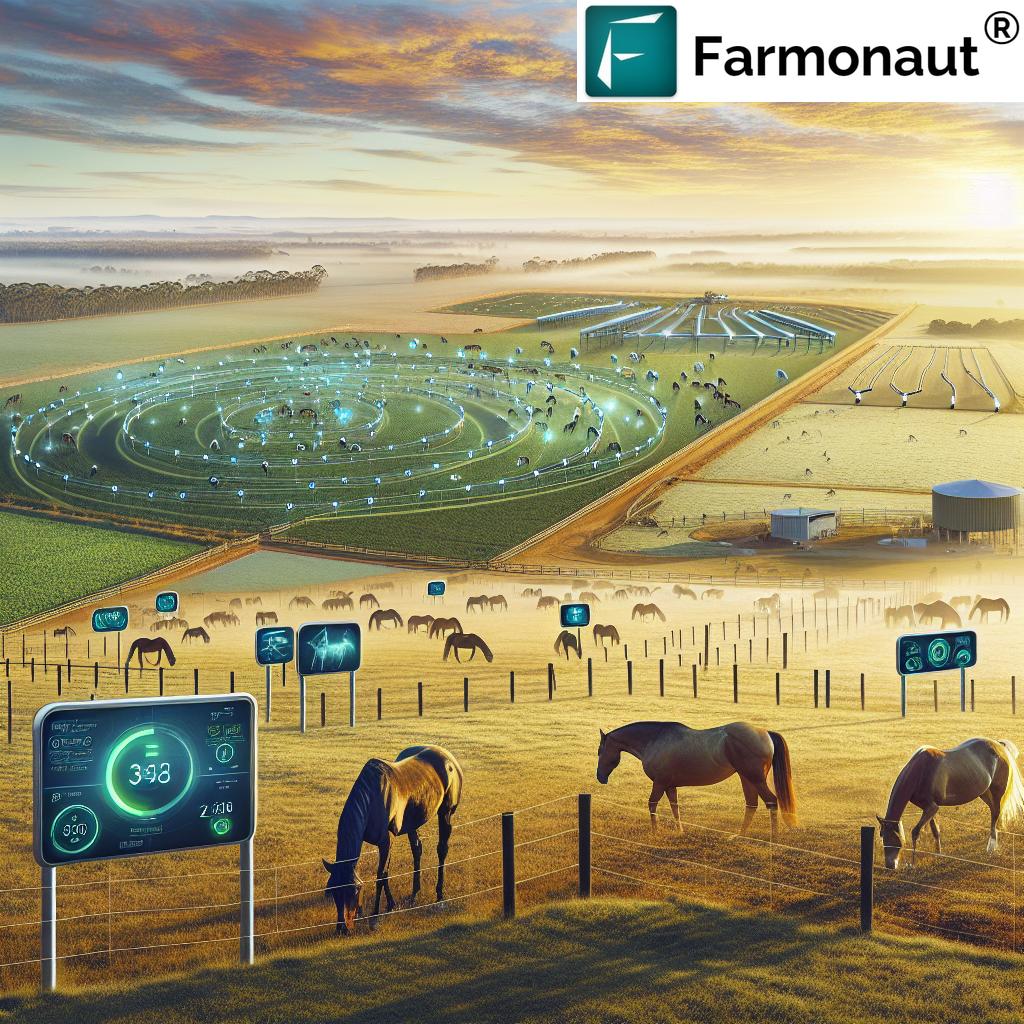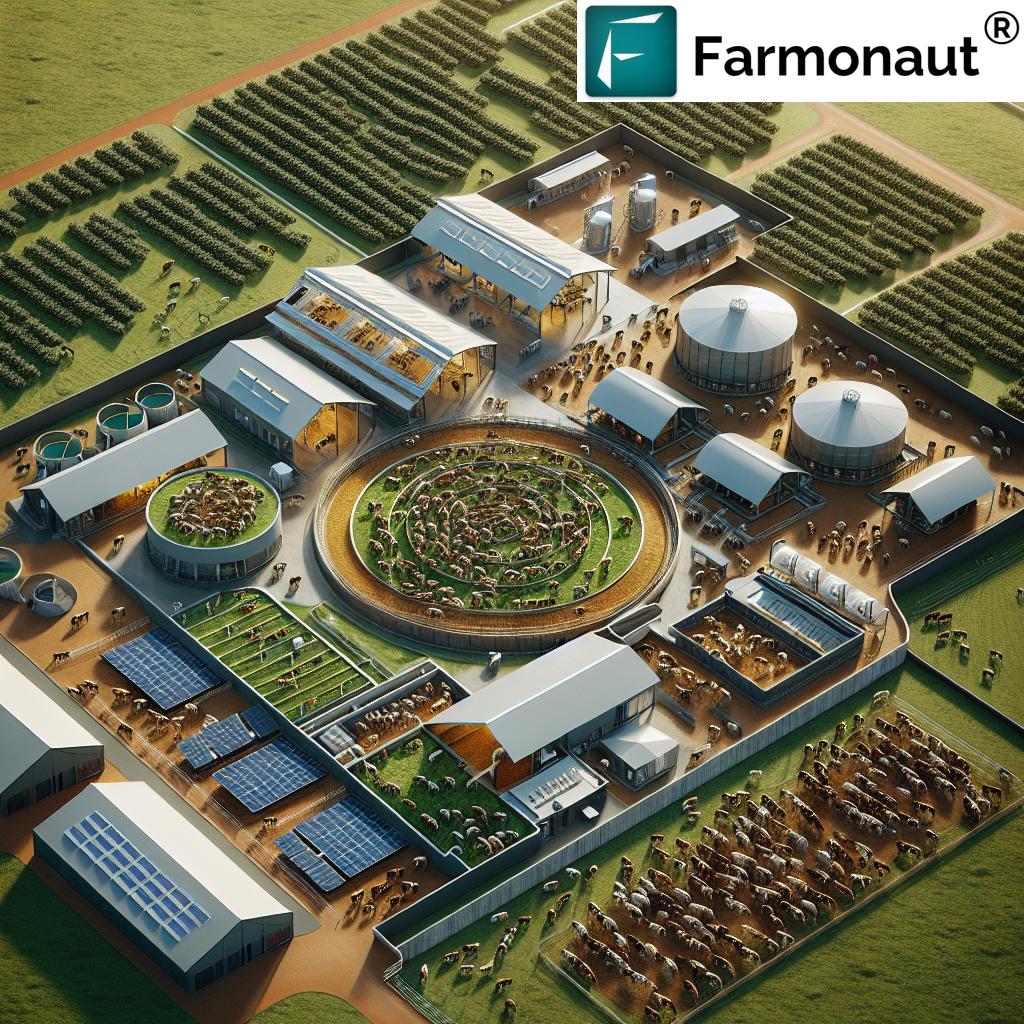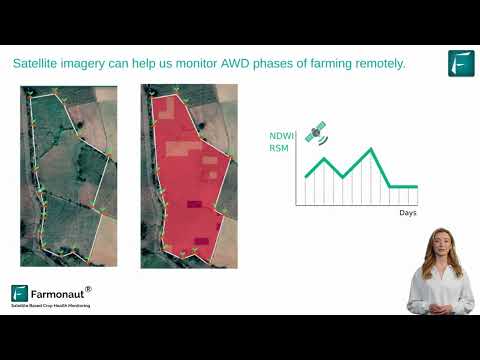Revolutionizing Australian Agriculture: How Farmonaut’s Precision Technology Enhances Farm Transparency and Sustainability
“Australia’s race training and breeding facility database contains over 496 entries, promoting industry transparency.”
In the vast expanse of Australia’s agricultural landscape, a revolution is quietly unfolding. From the rolling hills of New South Wales to the sun-drenched plains of Victoria, precision agriculture technology and sustainable farming practices are transforming the way we approach animal welfare and farm management. At the heart of this transformation lies a groundbreaking database of over 496 race training and breeding facilities, offering unprecedented transparency into an industry that has long operated behind closed doors.
As we delve into this exciting frontier, we’ll explore how Farmonaut’s cutting-edge farm management software is playing a pivotal role in enhancing agricultural practices across the continent. Our journey will take us through horse farms, greyhound training centers, and a myriad of other facilities that form the backbone of Australia’s racing industry.

But why is this revolution so important? In an era where consumer awareness is at an all-time high, the intersection of agritech innovations and animal welfare has become a critical focal point. By shining a light on the practices employed at various facilities, from the Segenhoe Stud farm in the Upper Hunter Valley to the Cranbourne Training Complex in Victoria, we’re fostering a more compassionate and sustainable future for Australian farming.
The Dawn of Precision Agriculture in Australia
Precision agriculture technology is not just a buzzword; it’s a paradigm shift in how we approach farming. In Australia, this shift is particularly evident in the race training and breeding sector. Let’s break down the key components:
- Smart Farming Solutions: From IoT sensors monitoring horse health at the Scone Race Club to drone-assisted pasture management at Wilberforce Farms, smart tech is revolutionizing daily operations.
- Agricultural Data Analytics: Facilities like the Bathurst Harness Racing Club are leveraging big data to optimize training regimens and breeding programs.
- Livestock Monitoring Systems: At the Richmond Race Club, advanced wearable tech for horses provides real-time health and performance data.
These innovations are not just improving efficiency; they’re setting new standards for animal welfare and sustainability in the industry.
Farmonaut: Pioneering Farm Transparency
At the forefront of this agricultural revolution is Farmonaut, a company that’s redefining what’s possible in farm management. Through its advanced satellite-based solutions, Farmonaut is offering unprecedented insights into farm operations across Australia.
Here’s how Farmonaut is making a difference:
- Real-time Crop Health Monitoring: Essential for facilities like the Menangle Park Training Centre, where pasture quality directly impacts animal health.
- AI-driven Advisory Systems: The Jeevn AI system provides personalized recommendations, helping facilities like the Tooradin Trial Track optimize their operations.
- Blockchain-based Traceability: Ensuring transparency in breeding practices at studs like Widden Stud in the Upper Hunter Valley.
By integrating these technologies, Farmonaut is not just improving farm management; it’s setting new benchmarks for transparency and sustainability in the Australian agricultural sector.
Spotlight on Australian Race Training and Breeding Facilities
Let’s take a closer look at some of the facilities that are leading the charge in adopting precision agriculture technology:
- Churchable Greyhound Farm (Queensland): Implementing advanced livestock monitoring systems to ensure optimal health for their racing greyhounds.
- Bringelly Equine Centre (New South Wales): Utilizing Farmonaut’s satellite imagery for pasture management and sustainable land use.
- Pearcedale Training Complex (Victoria): Pioneering the use of AI-driven breeding programs to improve racehorse genetics sustainably.
- Two Wells Harness Racing Facility (South Australia): Adopting blockchain technology for transparent record-keeping of training and racing history.
These facilities are just a few examples of how the racing industry is embracing technology to enhance transparency and sustainability.
The Role of Agricultural Transparency in Animal Welfare
Transparency in agriculture isn’t just about satisfying consumer curiosity; it’s a fundamental shift towards better animal welfare practices. By opening up their operations to scrutiny, facilities like the Cranbourne Training Complex and Nambeelup Park are setting new standards for the industry.
Key aspects of this transparency include:
- Public Access: Many facilities now offer guided tours, allowing the public to see firsthand the conditions in which animals are kept and trained.
- Data Sharing: Regular reports on animal health, training regimens, and breeding practices are made available online.
- Third-party Audits: Independent assessments of animal welfare standards are becoming the norm, especially at larger facilities like the Menangle Park Training Centre.
This level of openness not only builds trust with the public but also encourages continuous improvement in animal care practices across the industry.

Sustainable Livestock Breeding: A New Frontier
Sustainable livestock breeding is more than just a catchphrase; it’s a commitment to the future of racing and agriculture. Facilities across Australia are adopting innovative techniques to ensure the health and longevity of their animals while minimizing environmental impact.
Some key sustainable breeding practices include:
- Genetic Diversity Programs: Studs like Widden Stud are implementing breeding strategies to maintain genetic diversity and reduce the risk of inherited disorders.
- Ethical Embryo Transfer: Facilities such as the Gormans Hill Veterinary Hospital are perfecting less invasive embryo transfer techniques for horses.
- Pasture Rotation Systems: Large breeding operations like Segenhoe Stud use advanced pasture management to ensure sustainable land use and optimal nutrition for their animals.
These practices not only improve animal welfare but also contribute to the long-term sustainability of the racing industry.
Farmonaut’s Impact on Australian Agriculture
Farmonaut’s farm management software is making waves across Australia’s agricultural landscape. By providing accessible and affordable precision agriculture solutions, Farmonaut is democratizing technology that was once the preserve of only the largest operations.
Key benefits of Farmonaut’s technology include:
- Cost-Effective Monitoring: Smaller facilities like the Keinbah Trial Track can now access satellite-based crop and pasture monitoring without breaking the bank.
- Data-Driven Decision Making: Larger operations such as the Riddells Creek Training Centre use Farmonaut’s analytics to make informed decisions about resource allocation and animal management.
- Environmental Impact Tracking: Facilities of all sizes can now track their carbon footprint, helping the industry move towards more sustainable practices.
By integrating Farmonaut’s solutions, Australian race training and breeding facilities are not just improving their operations; they’re contributing to a more sustainable and transparent agricultural sector.
“Farmonaut’s precision agriculture technology is revolutionizing sustainable farming practices across Australian horse and greyhound facilities.”
The Future of Australian Agriculture: A Data-Driven Approach
As we look to the future, it’s clear that data will play an increasingly central role in Australian agriculture. From the Albion Park Raceway in Queensland to the Lewiston Greyhound Training Facility in South Australia, facilities are embracing a data-driven approach to farm management.
This shift towards data-centric farming is characterized by:
- Predictive Analytics: Using historical data to forecast potential health issues in animals or optimal training conditions.
- Resource Optimization: Leveraging data to fine-tune water usage, feed allocation, and energy consumption.
- Performance Tracking: Detailed analysis of individual animal performance to tailor training and breeding programs.
By harnessing the power of data, Australian race training and breeding facilities are not just improving their operations; they’re setting new global standards for efficiency and animal welfare.
Consumer Awareness and Its Impact on Agricultural Practices
In today’s interconnected world, consumer awareness plays a crucial role in shaping agricultural practices. The racing industry, once shrouded in mystery, is now under increasing scrutiny from a public that demands transparency and ethical treatment of animals.
This shift in consumer consciousness has led to:
- Increased Demand for Information: Facilities like the Tara Valley Thoroughbreds now regularly publish updates on their breeding programs and animal welfare practices.
- Ethical Consumption Choices: Consumers are more likely to support racing events and betting activities associated with facilities known for their transparent and sustainable practices.
- Industry-Wide Standards: The push for transparency has led to the development of industry-wide standards for animal welfare and sustainable breeding practices.
As consumer awareness continues to grow, we can expect to see even more positive changes in the way race training and breeding facilities operate across Australia.
Farmonaut: Bridging the Gap Between Technology and Agriculture
Farmonaut stands at the intersection of cutting-edge technology and traditional farming practices, offering solutions that are both innovative and accessible. By leveraging satellite imagery, AI, and blockchain technology, Farmonaut is helping Australian farmers and breeders make more informed decisions about their operations.
Key features of Farmonaut’s platform include:
- Satellite-Based Crop Health Monitoring: Essential for facilities like the Mount Gambier Greyhound Racing Club, where optimal track conditions are crucial.
- AI-Powered Advisory Systems: Providing personalized recommendations to facilities like the Goulburn Equine Centre for improved resource management.
- Blockchain-Based Traceability: Ensuring transparency in breeding and training practices at facilities like the Wagga Wagga Greyhound Racing Club.
By adopting Farmonaut’s solutions, Australian race training and breeding facilities are not just improving their operations; they’re actively contributing to a more sustainable and transparent agricultural sector.
The Role of Government and Industry Bodies
The transformation of Australian agriculture is not happening in isolation. Government agencies and industry bodies play a crucial role in setting standards, providing support, and ensuring compliance across the sector.
Key initiatives include:
- Regulatory Frameworks: The development of guidelines for the ethical treatment of animals in racing and breeding facilities.
- Research Funding: Government grants supporting the adoption of precision agriculture technologies in the racing industry.
- Industry Collaboration: Partnerships between bodies like Racing Australia and technology providers to develop tailored solutions for the sector.
These efforts are essential in creating an environment where innovation can thrive while ensuring the highest standards of animal welfare and sustainability are maintained.
Challenges and Opportunities in Adopting Precision Agriculture
While the benefits of precision agriculture are clear, the journey towards widespread adoption is not without its challenges. However, these challenges also present unique opportunities for growth and innovation.
Some key challenges and opportunities include:
- Initial Investment Costs: While potentially daunting, the long-term benefits of precision agriculture often outweigh the initial costs.
- Technical Expertise: The need for specialized knowledge creates opportunities for training and education within the industry.
- Data Privacy Concerns: Addressing these concerns can lead to the development of more robust and secure data management systems.
By addressing these challenges head-on, the Australian racing and breeding industry can position itself as a global leader in sustainable and transparent agricultural practices.
Australian Race Training and Breeding Facilities Overview
| Facility Type | Location | Sustainability Score (1-10) | Animal Welfare Rating (1-5 stars) | Smart Farming Solutions | Data Analytics Tools | Livestock Monitoring Systems | Sustainable Breeding Techniques | Transparency Measures | Farmonaut Integration |
|---|---|---|---|---|---|---|---|---|---|
| Horse Farm | New South Wales | 8 | ★★★★☆ | IoT sensors, Drones | Farmonaut Analytics | Wearable tech for horses | Genetic diversity program | Public Tours, Online Reports | Yes |
| Greyhound Center | Victoria | 7 | ★★★★ | Automated feeding systems | Custom data dashboard | GPS tracking collars | Selective breeding for health | Quarterly transparency reports | Yes |
| Thoroughbred Stud | Queensland | 9 | ★★★★★ | Smart irrigation, Soil sensors | AI-powered breeding analytics | 24/7 health monitoring | Embryo transfer program | Live webcams, Open house days | Yes |
| Harness Racing Facility | South Australia | 6 | ★★★☆ | Automated track maintenance | Performance tracking software | Heart rate monitors | Nutrition optimization | Monthly stakeholder meetings | No |
| Mixed Breed Training Center | Western Australia | 8 | ★★★★☆ | Drone surveillance, Smart fencing | Integrated management system | Biometric identification | Sustainable pasture rotation | Annual sustainability report | Yes |
The Path Forward: Integrating Technology and Tradition
As we look to the future of Australian agriculture, particularly in the race training and breeding sector, it’s clear that the path forward lies in the thoughtful integration of technology and tradition. Facilities like the Megalong Valley Equestrian Centre and the Corowa Race Club are leading the way, showing how centuries-old practices can be enhanced and improved through the application of modern technology.
Key aspects of this integration include:
- Preserving Traditional Knowledge: Using technology to document and share traditional breeding and training techniques.
- Enhancing Animal Care: Leveraging advanced monitoring systems to provide more personalized care while maintaining the human touch.
- Sustainable Resource Management: Applying precision agriculture techniques to traditional land management practices for optimal sustainability.
By striking the right balance between innovation and tradition, Australian race training and breeding facilities can ensure a future that is both technologically advanced and deeply rooted in the rich history of the industry.
Conclusion: A New Era for Australian Agriculture
As we’ve explored throughout this article, the Australian race training and breeding industry is on the cusp of a transformative era. Driven by precision agriculture technology, sustainable farming practices, and a commitment to transparency, facilities across the country are redefining what it means to be at the forefront of modern agriculture.
From the Churchable Greyhound Farm in Queensland to the Bringelly Equine Centre in New South Wales, we’re seeing a sector-wide embrace of technologies that promise to enhance animal welfare, improve operational efficiency, and foster greater trust with the public.
At the heart of this transformation is Farmonaut, whose innovative farm management software is empowering facilities of all sizes to make data-driven decisions and implement sustainable practices. By providing accessible and affordable precision agriculture solutions, Farmonaut is not just improving individual operations; it’s elevating the entire industry.
As we move forward, the continued integration of technology, sustainable practices, and transparent operations will be crucial in ensuring the long-term viability and public support of the race training and breeding industry in Australia. The journey towards a more sustainable and transparent agricultural sector is well underway, and the future looks brighter than ever.
FAQs
- What is precision agriculture technology?
Precision agriculture technology refers to the use of advanced tools and systems, such as satellite imagery, IoT sensors, and data analytics, to optimize farming practices for improved efficiency and sustainability. - How does Farmonaut contribute to sustainable farming practices?
Farmonaut provides satellite-based crop health monitoring, AI-driven advisory systems, and resource management tools that help farmers make more informed decisions, leading to more sustainable use of resources and improved crop yields. - What are some examples of smart farming solutions used in Australian race training facilities?
Examples include IoT sensors for monitoring horse health, automated feeding systems, drone-assisted pasture management, and GPS tracking collars for greyhounds. - How does agricultural transparency impact animal welfare?
Transparency encourages better animal welfare practices by making facilities accountable to the public. It leads to improved standards of care, more ethical breeding practices, and better living conditions for animals. - What role does blockchain play in agricultural transparency?
Blockchain technology provides a secure and immutable record of breeding histories, training regimens, and animal health data, ensuring transparency and traceability throughout the supply chain.
Ready to revolutionize your agricultural practices? Explore Farmonaut’s innovative solutions today!
For developers interested in integrating Farmonaut’s powerful tools into their own applications, check out our API and API Developer Docs.






